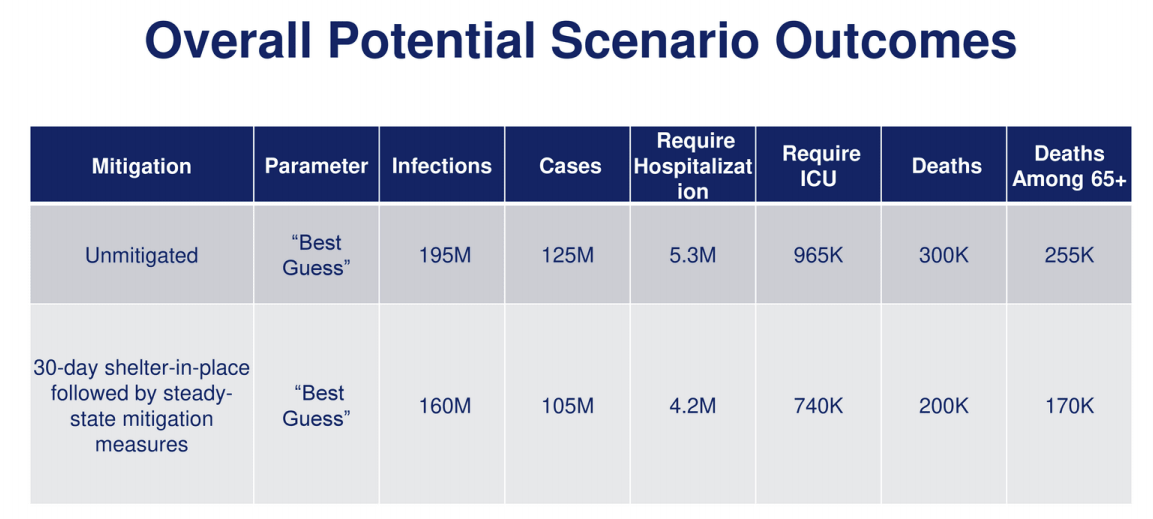The New York Times had a story at the end of last week: a Department of Homeland Security document (a PowerPoint slideshow, in fact) saying that a “best guess” death toll, if shelter-in-place policies are lifted after 30 days, would be 200,000. That contradicted Donald Trump’s own claim that the count would come in under 100,000.
I’ve taken a look at the slides, and they do indeed say what the NYT reported them as saying. But I wonder if they’ve buried their own headline.
That is: the slides do not only predict the number of deaths; they predict the number of people infected. Under a do-nothing scenario, the “best guess” is 195 million infected and 300,000 dead; under shelter-in-place for 30 days followed by other “steady-state mitigation measures”, it’s 160 million and 200,000.

The “infection fatality rate”, remember, is deaths divided by infections. For the do-nothing scenario, 300,000 divided by 195 million is 0.0015, or 0.15%. For the shelter/mitigation scenario, 200,000 divided by 160 million is 0.00125, or 0.125%.
An IFR of 0.15% would be below even the most optimistic estimates. The Imperial model has assumed an IFR of 1%. Early findings from Germany and Iceland put it more like 0.4%, but people generally expected that to be an underestimate.
If the IFR is really low, that means that more people have had it, which in turn means that we might be further through the epidemic than we thought.
I’m uncomfortably aware that this is exactly what I want to believe, so I ought to be extra wary. Also, I don’t know what the Homeland Security numbers are based on. You’d hope that it’s not just plucked out of the air and that they have some sort of testing data that they haven’t released, but who knows. I certainly don’t suggest that we ought to change course on the back of one leaked PowerPoint slide.
But if it’s anywhere near true — even though it mentions 200,000 deaths — it’s actually good news, not bad. It would be down near the most optimistic estimates. Of course, if they’re wrong and the IFR is much higher, then the predicted death toll should be correspondingly higher.








Join the discussion
Join like minded readers that support our journalism by becoming a paid subscriber
To join the discussion in the comments, become a paid subscriber.
Join like minded readers that support our journalism, read unlimited articles and enjoy other subscriber-only benefits.
SubscribeTom, you really should be aware that the NY Times, apart from being completely unable to tell the truth on any subject, is also completely unable to analyse data or statistics. (To be fair, this applies to most of the media, which is largely innumerate).
As for this particular issue, it becomes more obvious with each passing day that millions of people contracted this virus without displaying any symptoms. My understanding is that when extrapolated, the numbers that tested positive in Iceland suggest that 50% of their population contracted it.
The whole thing is a bigger scam that post-modernism and climate change – or at least the response to climate change – combined.
I’d like to think you are right, but really I don’t think you are. According to the report cited below, “Although fewer than 1% of the tests came back positive for the virus, the company’s founder Dr. Kári Stefánsson told CNN that around 50% of those who tested positive said they were asymptomatic.” They have not done antibody tests, so do not know how many people may have had the virus already without being aware. But you’d need to be an extreme optimist to think that half the population may have already had it, given that there are 1,086 confirmed infections in Iceland and 927 people currently in isolation, while more than 5,000 have left quarantine, out of a population of c364,000. On a rough estimate, doubling the number of confirmed/suspected cases to account for those who had no symptoms, it suggests to me that about 14,000 people there have the virus or have had it, so under 5% of the population.
https://edition.cnn.com/202…
Tom, so many (including me in January) think they already had Covid it’s a bit surprising there isn’t a widespread poll to find out unless i haven’t seen it. MORI did a poll but it’s sample was quite small – about time the ball got rolling?
It is clear from the German research that this Virus is not as dangerous as first believed. They even believe that it is becoming less threatening with time. The West needs to open up its economy and it should be upto the vulnerable including myself to self isolate. The loss of income and aspirations of the young is not a reasonable policy.